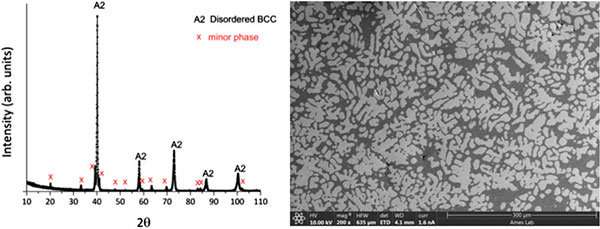Team takes the guesswork out of discovering new high-entropy alloys

The U.S. Department of Energy's Ames Laboratory has developed a method of computational analysis that can help predict the composition and properties of as-yet unmade high performance alloys.
These materials are made up of multiple elements (four or more) and highly sought after for their simple structures, excellent mechanical properties over a wide range of temperatures, and improved oxidation or corrosion resistance. Advancements in these materials could lead to enhanced jet engine performance and fuel efficiency, as well as other applications in industries where mechanical parts must operate in harsh environments.
"What's traditionally been done in materials design is tweaking what we know about materials that have already been discovered, and we know that even small changes in the composition of alloys can result in big changes to their properties," said Duane Johnson, Ames Laboratory scientist and computational theorist. "But that means there's a ton of undiscovered territory out there, especially in alloys made of four or more elements."
Given the sheer number of possible alloy composition combinations, it would be difficult for experimentalists to know where to look for the next new high-entropy alloy. Not only that, high-entropy alloys are notoriously difficult to make, requiring expensive materials and specialty processing techniques. Even then, attempts in a laboratory don't guarantee that a theoretically possible compound is physically possible, let alone potentially useful.
"A good place to start then," said Johnson, "is being able to tell experimentalists where NOT to look." Using a high-throughput computational approach, the researchers used a unique electronic-structure method to predict properties of any arbitrary high-entropy-alloy composition, simultaneously assessing their ability to form a solid-solution in simple structures, their atomic ordering, their chemical stability, and their mechanical properties at changing temperatures.
"Our calculations answer a number of questions, the most important being 'is it even worth looking here?'" said Johnson. "We can narrow down the design space for multi-component systems, and circle the area(s) on which to focus for the most promising materials for investigation or development."
The research is further discussed in the paper, "Design of high-strength refractory complex solid-solution alloys," authored by Prashant Singh, Aayush Sharma, A.V. Smirnov, Mouhamad S. Diallo, Pratik K. Ray, Ganesh Balasubramanian and Duane D. Johnson; and published in npj Computational Materials.
More information: Prashant Singh et al. Design of high-strength refractory complex solid-solution alloys, npj Computational Materials (2018). DOI: 10.1038/s41524-018-0072-0
Provided by Ames Laboratory


















